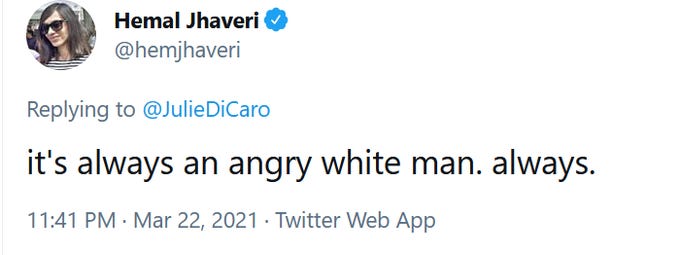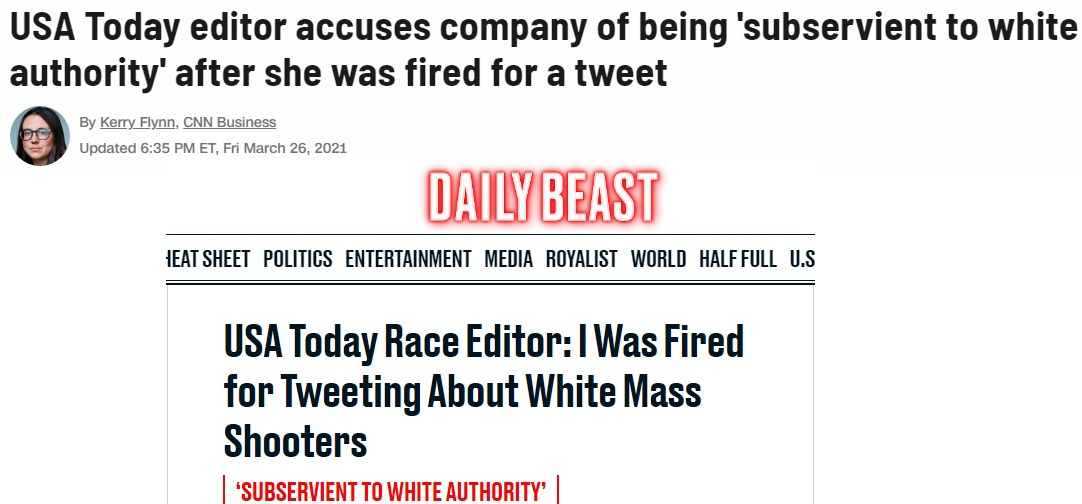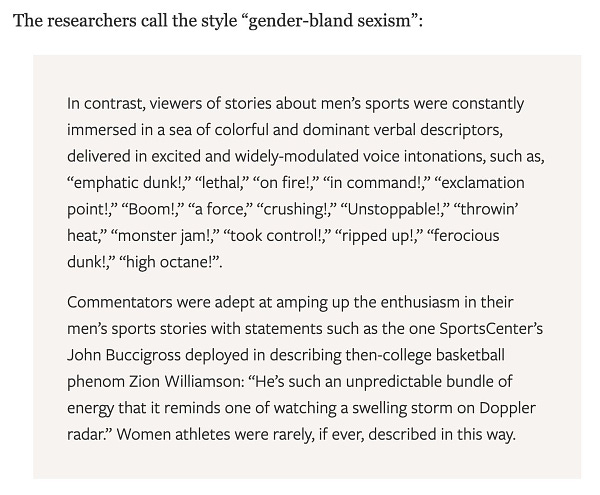A powerful example of the immorality, groupthink, and self-defeating motives of Wokish media snipers
Sidebar: Homicidal young males aren't the only Americans advertising their sexual frustrations
After some loser whose name I intend to never commit to memory killed 10 people at my local King Soopers last Monday, the broad expectation that the loser would turn out to be a young, disenfranchised white male, though not one easily mistaken for Brad Pitt, was quite reasonable, statistically speaking. So, too, are a lot of potentially discourse-altering inferences, such as: “A randomly selected teenager who declares themselves trans will most likely later change their mind,” which must be an unpleasant outcome for those already shepherded into sterility-inducing medical procedures, or “a randomly selected American man was slightly more likely in 2020 to favor a woman’s legal right to abortion than a randomly chosen American woman.”
But even if one grants that human minds are inclined to round up high probabilities to 100 percent (and low ones down to zero), especially when the emotions in those minds are swirling amok, this is not license for members of the media to act on these high-probability hunches and start trumpeting them as conclusions. In theory, while the costs of losing a gamble like that are fairly low when talking drunkenly to yourself in front of CNN, they can and should be high when prematurely pulling the trigger while taking an openly racist stance as an employee of a major McPaper.
One of the multiple people with significant platforms who impulsively tweeted out that a white male had committed the Boulder murders was Hemal Jhaveri, who at the time held a title that until five years ago would have been found only on wadded-up sheets of paper in a Comedy Central writers’-room wastebasket: the USA Today Sports Media Group’s Race and Inclusion editor.
(Here’s a safe bet you’ll have many opportunities to make in the weeks and months to come: Anyone with a job title pertaining to racial justice in 2021 will prove to be a flagrant racist themselves, because these positions were created by and for Wokish people, all of whom are either agitators of anti-white racism or their duped water-carriers. In fact, take this a step further: Whenever someone drops the word “inclusion” around you, immediately assume you’re dealing with a relentless mental defective, and be prepared to deflect a farrago of nonsense and, if possible, establish a rapid and punishing rhetorical counter-offensive.)
Among the others in this warbling online chorus of lies—and if you blare something to the world as a fact with your only source being a tweet that turns out to be false, then you’re a liar yourself— was Vice President Kamala Harris’ daughter, another person whose full name I don’t care to learn.
As I’ve suggested, the collective assumption at work in Jhaveri’s tweet itself—that a mass shooter of yet-unknown ethnocultural provenance was surely another fleabag Caucasian male—is not only forgivable but practically automatic. And in today’s airport-smoking-lounge media environment—where everyone with a personality disorder and a blue Twitter checkmark soon gains exalted status before landing in rehab, on unemployment, or married to the earner they were after all along—even an errant tweet from a representative of the media would be forgivable if coupled to a hasty retraction, a sincere apology, and, critically, evidence of the sort of internal policing required to ensure that the first two are normative expectations.
But what happened in the aftermath was both scary and instructive, underscoring that Wokism is not about “inclusivity” or “justice” but blind, sweeping payback—anti-white racism, anti-cis-male sexism (and maybe genderism; who the hell cares, really) and the unbridled enabling of these solecisms and their attending lies by the whole suite of liberal media entities. We* have always had media liars, but in the past, they were punished, not protected. And all of this is certainly grounds for taking the piss out of a flurry of morally and ethically repugnant would-be reformers in the joggersphere.
Jhaveri was fired by USA Today late last week. But rather than express any meaningful contrition at all, she took to Medium and, in another 100 percent safe bet, blamed everyone but herself, including the alt-right, whose influence apparently led to her impulsive tweet-shart. She tried to pretend that trying to cover her ass and tracks by deleting a tweet that had only made her look like an imbecile was instead a magnanimous and fully reparative act, and—with no trace of irony at all—reaffirmed her commitment to being exposing and battling “whiteness.”
It is evident from her screed that, well before her Monday tweet, Jhaveri should have been shown the virtual door of USA Today and asked to never return. Whatever she might be good at, besides wearing sunglasses and shirts with horizontal stripes, legitimate media work—or anything requiring personal integrity—is not among her skills.
Other than Fox News, almost all of the major outlets that reported on Jhaveri’s firing went along with the 2021 social script and portrayed her as a victim, too; the Daily Beast lied or propagated a lie about why she was actually fired.
Then there’s Jezebel, whose phallophobic contributors I imagine smoking Midol and setting fire to kerosene-soaked, castrated dolls of Louis CK with welding torches while they concoct passages like these: “Facing manufactured pressure from a bad-faith right-wing ecosystem hellbent on false equivalencies, USA Today took the bait.”
Absent from all of this wagon-circling, of course, was the fact that second chances after pretty grave or even made-up transgressions are never, ever on the table when it comes to a cancellation target of one of these Twitter-scurrying, chickenshit wharf rats. It’s never “Well, maybe he’s just human and that tweet 11 years ago when he was 14 was just him being 14.” If he’s white, it’s off with his head, ideally including his earning potential.
This episode also highlights how the Wokesters’ primary and pathological fixation on group identity comes back to haunt them—or would, in a climate in which brazen, divisive mistakes by assholes like Jhaveri actually mattered to their careers more often. In the initial photo of the Boulder shooter that zipped around the world, the perp did in fact look “white.” If it hadn’t become perversely fashionable to find a group to blame every time an individual deviant does something awful, the Midol-smokers and their ilk might not have wound up with yet more black marks on their already shameful records. That they did wind up with such scars most likely doesn’t concern them anyway.
And, in a detail I assume has been explicitly omitted from most media coverage, the murderer also looked like the kind of glum, holistically underactive 21-year-old who had never been laid in his life (or at least not lately), was displeased with this dispiriting state of affairs, and would have had a hard time even mustering up the nerve to overpay $75 for sex in the back of an Econoline van. Pulling out a real gun is easier, and they never go soft at inopportune times.
If there is a true unifying factor among these saddest of sacks, it’s that none of them look at all like, say, George Clooney. In fact, Clooney, now sixty or whatever, could spend six months on my couch living on Wild Turkey and Big Macs and emerge—fart-and funk-encrusted and incomprehensible, though probably with his trademark head-waggle intact—with better prospects than any mass shooter in recent memory, regardless of ethnicity or any stated motivations. While it’s true that the vast majority of celibate or striking-out males don’t act violently as a result (think of how much of civilization would burn to the ground every night if even 10 percent of sexually frustrated males did in fact channel their frustrations into violent actions), it does seem to be a unifying factor, albeit one signifying a more generalized form of social isolation.
What to do about these “lost males”—and, though this is a different discussion, the vagaries of human gametes and reproduction ensure that both history’s most gifted geniuses (by some measures) and society’s most wayward dimbulbs (by every measure) will be men—is a difficult question, and, since they can readily turn into monsters, an urgent one. All I can say is that most people seem to adapt okay to not being regarded as model-handsome, debonair, or a prized catch. My own mother loves me dearly, and she used to drop the phrase “tall, dark and handsome” around me despite knowing I was destined to be otherwise.
How’s this for unfair? Women, as a basic fact of biology, overwhelmingly want to be with someone who is at least noticeably taller than themselves, which for straight guys doesn’t really start limiting the selection of mates until you get down below, I dunno, 170 cm? (Go ahead, reach for the calculator.) And men are similarly attracted, on average, to a fairly predictable cluster of physical attributes. None of this is breaking news, but it seems like a lot of very basic human psychology is going unaccounted for in the ongoing culture wars.
Whatever the case, each of us is stuck to different degrees with physical characteristics ranging from the somewhat imperfect to the borderline obscene. And it seems that until social media and the current generation of young adults came along, the average human was better at accepting they weren’t going to be in the same desirability conversations as Jake Gyllenhaal (I just love typing his name) or Yvonne Strahovski (same, same), or even be treated as well at times as the jock or cheerleader with the brains of a palmetto tree who fails upward at every important step.
If I’m reaching into my ass here, it still gives me a legitimate segue into more a blog-centric topic.
Alongside all of this abject, infantile stupidity, I took note of a few chirps in the ongoing “PEOPLE 👏 SHOULD👏 WATCH 👏 MORE 👏 WOMEN’S 👏 SPORTS!👏” rally-cry from women who fancy themselves both athletes and members of the media, with only the second of these operating principles occasionally being true.


Please pause for a moment to consider two of the most urgent imperatives emanating from the version of running now held hostage by Wokish dick-twisters: Never mention bodies, ever, unless you have explicit permission; and running itself is a hotbed of crushing racism, sexism, environmental injustices, beatdowns of transgender kids, and other problems that can only be ameliorated by pointing a firehose of lies at everyone in the running world who fits the rough description of an oppressor, i.e., anyone who pees standing up and requires a lot of sunscreen.
Would you as a sports fan be drawn into this environment by choice, other than as someone writing a doctoral dissertation on abnormal social psychology? Would you want to watch broadcasts with all references to the physical traits of the athletes involved stripped out in an effort not to offend someone eating ice cream in the corner in Topeka? Would this even be tenable, given the nature of, well, sports?
Someone should ask these harpies: What is your plan for getting more people more interested in women’s sports, other than carping on Twitter about supposedly unfair numbers and lying to the entire world about a fake comeback? These women couldn’t run a fucking lemonade stand, or operate a water fountain, much less administrate or popularize a sport. And they know it.
It’s one thing to insist on the overtly sexualized aspects of sports promotion to go; for example, while I don’t really want to put anyone out of a job, NFL and various other female cheerleaders, whom I already slandered in preparation for the kill, can probably be eliminated (you’d have to survey sports fans as a whole on this one, I suppose, but I think the Wokish would favor it). But the demands of this crew, like all “social justice” demands, are not in this or any zone of negotiability. They want what they want, even when they know what they want is nothing most people would want at all. Like Jhaveri, they just want to look correct in the moment and enjoy the thrill of their peers’ mass electronic approval.
I will add, and I don’t know how much this issue is on younger, or any, women’s minds anymore, that sometime around 1988, it suddenly became standard for women runners at the NCAA and higher levels to race in “bun huggers.” I remember seeing these for the first time while watching the University of Vermont women’s team race Plattsburgh State at a home meet, and wondering who had made the weird decision to put women in underwear for their races. One of my fellow freshman teammates, popping a few pimples as he stood alongside, was equally curious. “Do you think that looks sexy?” he asked, thoughtfully spitting on his own shoe. My strongest impression was that they looked uncomfortable, and not something anyone would wear if she believed it was really optional. Also, as a budding progressive, I smacked down his objectifying language and opined that something like bike shorts, only even shorter, would be both more comfortable and sexier for us pimple-poppers. Without knowing it, I had just described, but failed to invent, the garment that would come to be known as “spankies.”
In any case, I don’t blame any women who lived through that era, and didn’t really have much of a choice but to race in clothing they weren’t comfortable with, for having an axe to grind about all of this. I still want to know who came up with the not-really-optional-if-you-wanna-be-cool bun-huggers idea and why it sailed through with so little resistance from women, even in the 1980s.
But getting back to my references to various sex symbols, I cannot help but notice that not every runner is on board with the functional elimination of body-talk from running, and that those who ignore the plaintive cries of the Woke seem more than comfortable with their own bodies and others’ inevitable appreciation of them. I have mentioned the rise of the ass-wagglers before. It’s painfully clear why some people want shameless women like Cory McGee to have a, well, lower photographic profile. (Exceptions are made when it’s time to suck up to an Olympian.) When a cluster of people exists who rate themselves as threes, fours and fives on a scale of ten—no matter how the people most important to them see them—in an age when everyone feels the need to be at least an eight, this kind of complaining is inevitable. And the need to feel extraordinary for no reason goes beyond looks.
Bitches, deal with it. Someone out there loves you even if I don’t. I’m kind of a skank myself, a collagen scarecrow fraying and unraveling by the second, and almost everyone likes me anyway.
Maybe that all sounds too simple, too mean, or both. But I have a fairly well-honed Occam’s razor, and at this point I don’t know that it’s actually possible to be overly mean, in print, to any of the offenders I have chronicled here.
In any event, the singular episodes of damage from these insecurity flare-ups are undeniably less great than when a mass shooter strikes; it would be maniacal to equate even the most unequivocally termination-worthy journalistic faux pas and a subsequent display of cuntic recalcitrance with an act of violence, lethal or otherwise. But that’s only because it doesn’t get much if any worse than mass murder, and those thankfully don’t occur every day (yet).
Moreover, society doesn’t support incels working out their angst by targeting other people. When this manifests as bloodshed, it’s easier to condemn. But when taking out personal insecurities on others instead become woven into entire institutions, such as the media and the university system, and this is semi-convincingly disguised as social activism, it becomes harder to fight, and, as a daily and ever-more-persistent cultural feature, harder to even identify as aberrant.
The reason people like Lindsay Crouse and the rest of the depraved figures I write about can refuse to acknowledge, much less be forced to explain, their own bald-faced, wildly amplified lies has been illustrated above with perfect clarity: When everyone in a subculture or organization is a liar or otherwise behaving in ways that would otherwise get any one individual in serious trouble—and folks, lying on the job is bad, but doing it as a journalist is inexcusable—then no one malevolent actor pays a price. The next time you see a U.S. senator smiling at the camera and telling an obvious, appalling lie, ask yourself if he or she is the only one pushing that nutty narrative; invariably, you’ll find that this kind of gaslighting is a group effort, not only making it more potent in the eyes of already credulous supporters, but also insulating individual dirtbags from consequences even when the truth becomes widely known.
This in turn gives away the “social justice” lie. Any movement that is really concerned with fairness seeks to correct liars and others who discredit the good work of honest activists, or purges from their ranks outright; it doesn’t want to achieve its ends through the very skullduggery it purports to oppose. In Wokism, lying on behalf of the cause is not only permitted but encouraged—just like lying for Jesus is okay in conservative Christianity.
These people are not credible, full stop.
Perhaps my hypothesis—that the way individuals behave within an ostensibly group cultural movement can be readily reduced to exquisitely personal reasons on cursory analysis—if full of holes. But at this point, I’m forced to try to explain why an entire industry has fallen into the clutches of trenchant and unrepentant liars. Since none of them is acknowledging any of it, not only do I feel free to be as far-reaching as possible in my speculation, I feel obligated to do so. If people choose to not answer for their crimes, perhaps they can be made to think in a more useful way about what is actually fueling them and where they are likely to land those who commit them.
I’m sure it all feels like a tremendous, powerful rush at the moment, getting paid to write lies about people and about the others producing those lies, like drunks smashing bottles and chairs in a bar simply because they see others doing the same and cheering…and because the unseen tab, plus damages, hasn’t yet come due.
We’ll* see.
On Sunday afternoon, I took a break from writing this and went for a run on the warmest day of the nascent spring. I’m not sure if it’s more people being vaccinated, or the weather, or a deepened sense of post-tragedy community, but more people than I have seen in some time were boasting smiles out there, myself among them, and I could see this because a lot of them had decided that masks weren’t necessary from all the way across the street, or even halfway across. Rosie, my furry and unflappable seven-year-old, got some random attention from others out for exercise.
There is a sense about the paths and meadows of things returning to Boulder-normal, but more than that, it’s nice to know that no matter what else is going on in other runners’ small yet swelled heads, it’s hard to imagine losing the joy of the activity itself.
(Bonus material: The quintessential angry white man.)






